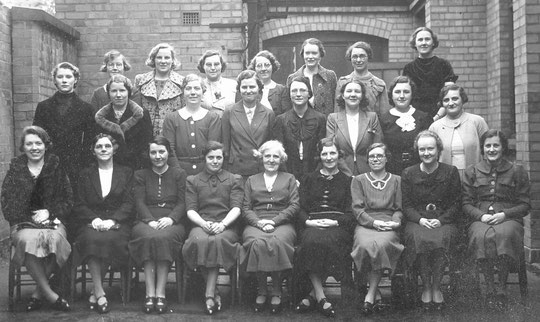History of our Church


Ladies Bible Group - Christine Jennings (Acocks Green Historical Society)
Alexander Road’s Acocks Green Chapel was opened in 1903 at a cost, exclusive of furnishings, of £2,260, and was built on land presented by J. Walker. Designed by Ingall and Son of Birmingham in the ‘free Gothic’ style it provided sittings for 300. A new chapel, seating 470, was completed in 1914 for £4,177. The church, formed in 1903, stemmed from a meeting of local Baptists gathered by J. Walker in 1902, and for some time received help from Coventry Road Baptists.
The church buildings that began in 1902 were finally completed in 1924 with the addition of the room then known as New Hall. This fronted Yardley Road with its back door opening onto the passageway which divided the house and led to the chapel kitchen and other large rooms.
The complete complex consisted of the Church, four main halls, eight small rooms, seven toilets, six lobbies, two yards and passages. Commemorative names were not added to the rooms until the 1950s.
For the first 10 years, the Big Hall was the original church. The large entrance lobby was equipped with moveable coat racks and there were two toilets and two other small rooms. In the 1930s this was used for gymnastics and was complete with a climbing rope, ceiling mounted rings, parallel bars, vaulting horse, and with the large coconut mats, dumbbells, India clubs etc. it was a well-equipped gym.
Up until 1934 this hall was also used as a Infant and Junior school by the Birmingham Education Department, only ceasing when a purpose built school was opened as Yardley Rd Junior and Infants school.
The small hall by the side parking area was regularly used by the Cubs and Scouts of the 232nd Birmingham Boy Scouts group. During the war it was used by the Young Peoples Fellowship on Sunday Afternoons. They then moved into the upstairs hall later in the war with the billiard table being erected at one end.
The last hall to be built was the New Hall in 1924 with a permanent stage at one end with extensive storage space at the other end. Curtains were also placed in position with spaces either side for performers, scenery and props.
The hall was used for Women’s Social Hour, Baptist Women’s League, Junior Sunday School, and a favourite for Wedding Receptions – although there were drawbacks to this as the church is strictly teetotal so as no alcohol was permitted the guest drank lemonade, and no dancing was allowed either, so weddings were a much quieter affair.
Both the New hall and Hall were used as polling stations, the Girls Life Brigade staged many pageants and displays and the Young People’s Fellowship staged regular concerts and plays.
In wartime – 1939-1945 blackouts were installed on all windows in all halls, but not the church sanctuary, and in winter months evening services were held in the Big hall.
The Big hall was the designated to be used for families made homeless by German air raids on the city. During the raids, the closest high explosive bomb destroyed two houses about 200 yards up on Alexander Road, however, the immediate area was showered with incendiary devices, two of which fell on church premises. One hit the lobby at the end of the side entrance in Alexander road and the other came through the flat roof of the old billiard room. A stirrup pump (hand pump into buckets of water) quickly extinguished the fires.
For many years the Sunday School Anniversary ran on two consecutive Sundays. The Sunday School attracted many youngsters from the local community and all the main rooms were filled on a Sunday afternoon with up to 150 children.
in 1944, Sir William Dobbie, the governor of Malta during the siege of 1940-1943, came to preach to a packed and over flowing church congregation.
The Baptist Church Sanctuary is now a Grade II Listed building. Built in red brick in 1913, its architecture is of the Arts & Crafts style. The 1903 terracotta church hall on Alexander Road (now the Arthur Moore Hall & Upper Room) is also Grade II Listed and was built in a free Flemish Gothic style ten years before the sanctuary. There are some interesting features including angels and putti. Another hall (now the Glynn Edwards Hall) in an Arts & Crafts style was built in 1924 on the corner of Alexander Road and Yardley Road, filling the gap between the two earlier buildings.
